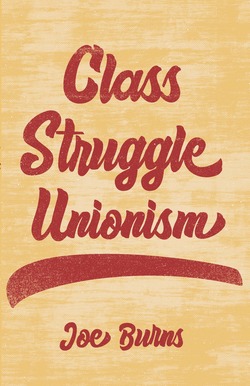I have only started reading Joe Burns’ new book, Class Struggle Unionism, but I feel a need to report on some important ideas that he introduces in Chapter Three, titled “Beyond Labor Liberalism.”
There is a trend in the labor movement that is often called, somewhat pejoratively, “Business Unionism.” These are unions led by officials and bureaucrats who focus almost exclusively on winning better wages and working conditions for their particular sector of workers, and who show little real solidarity with other workers.

Of course, few unions proclaim themselves to be “business unions.” There is a whole range of unions that style themselves as progressive in one way or the other. But, Burns says, many of these unions look more different from business unions than they really are. He calls these unions “labor liberals.”
Burns calls for a decisive break with both business unionism and labor liberalism, in favor of what he calls “Class Struggle Unionism.” Burns outlines a continuum of outlooks, policies and structures that define these three different kinds of unions.
Business unions will fight periodically, especially when a new contract is being negotiated, but then relapse into long periods of “labor peace.”
The labor liberals often use more confrontational tactics and more militant rhetoric than the business unions. They hold rallies and demonstrations, but workers at these actions are “typically used as props… trotted out to give scripted remarks.” Then, once any particular campaign is over, the labor liberals all too often become missing-in-action as far as the rank-and-file worker is concerned until the next battle is upon them, just like the business unionists.
Class struggle unions, Burns claims, recognize that struggles with the bosses go on day in and day out, and that it is thus necessary to maintain a fighting posture at all times. A union leadership that demobilizes its workers between campaigns has a hard time holding onto its victories.
This fundamental difference in outlook results in fundamental differences in organizational structure.
Business unions usually make no bones about having a tight leadership group firmly and unmistakably in command. The stereotype of the old-fashioned cigar-chomping union boss easily comes to mind.
The labor liberals, on the other hand, use the rhetoric of democracy. But in reality, the unions are run by a few “Big Heads.” The labor liberals fight the bosses, but conduct “tightly choreographed” campaigns with the dominant role played by staff organizers. As one of my good friends used to say, some union leaders only want to mobilize workers “from the neck down.”
Class struggle unions instead have a core belief in the old axiom that “the emancipation of the working class must be the work of the working class itself.” As Burns writes, the officials and staff in unions led by labor liberals “seek to save workers; class struggle unionists seek to help workers liberate themselves.”
Class struggle unions are led by the membership, with the officials and the staff working for us, rather than the other way around. It means that we must have real rank-and-file democracy on all levels, including determining goals and strategy. It means that our unions must be based on strong shop-floor organization.
The methods by which both the labor liberals and business unionists maintain their control are easily recognizable. They often create “mega-locals,” where the business of the union is conducted far away from the workers. The officers in charge might run as a slate, making it hard for rank-and-file activists to compete for leadership positions. The officers are likely to meet in secret, and be less-than-forthcoming when workers try to find out what is being discussed. Union meetings may be few and far between, and manipulated in many ways so as to preclude any real discussion or debate. Business agents and shop stewards are appointed by the officials, rather than elected by workers. Staff is often recruited from outside the union, rather than from the ranks of workers who know what they need and the terrain on which they must fight.
As Burns points out, these trends differ even on something as fundamental as fighting to organize the unorganized. The business unionists tend to just circle the wagons and defend already-organized workers. The labor liberals often do a better job of organizing the unorganized, but abandon the defense of the organized in the process, using the excuse that they are just too busy. Class struggle unionists understand that both defending organized workers and organizing the unorganized is of the highest priority.
Burns approvingly quotes law professor Matthew Dimick, who argues that “a strong, class-conscious labor movement is built on worker self-activity:
“Strikes and other concerted activities are not merely means by which workers achieve gains in the workplace. Rather, they are moments in the process by which workers constitute themselves as a class – building solidarity, raising class consciousness, creating their own norms and institutions, and discovering their own forms of class power.”
We all know that the labor movement is in deep crisis. The number of union workers in the US continues to decline to historic lows, despite some valiant struggles in recent times. Many look to the more progressive “labor liberals” to lead us out of this crisis. Burns, however, declares that the labor liberals are incapable of fundamentally altering the balance of power between workers and bosses.
“Let’s be honest,” he writes. “We have no plan to revive the labor movement. For several decades, we have attempted to revive unionism within a political and legal system set up to benefit the billionaire class. It’s not working… To take them on we need our own philosophy – class struggle unionism.”
I am looking forward to reading and reporting on the rest of Burn’s book, including his call for the “abolition of the billionaire class.”
Marc Norton’s website is at https://MarcNortonOnline.wordpress.com.



